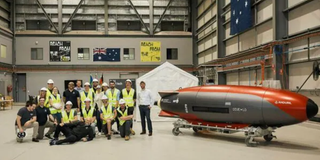Underwater battles heat up with Australia’s sea ‘drone’

Australia unveiled a prototype for its unmanned combat vehicle in what analysts say is a response to China’s recent launches of similar vehicles.
China and Australia may not be the biggest of enemies. But a technology race is building up between them which could tell us how the future of underwater wars may occur.
For Beijing, the ambitions had been to advance technology for unmanned aerial vehicles (UAVs) also known as drones. But of late, China had been giving bits of its developing focus on submersibles, or ‘sea drones’ which can operate under water.
The exact use of the vehicles has not been publicised but sea drones, just as aerial ones could be good in military intelligence gathering, spying, scientific research on the changing nature of the sea or planting explosives to deter enemies.
This week, Australia unveiled a prototype for its unmanned combat vehicle in what analysts said was a response to China’s recent launches this year of similar unmanned submarines.
AsiaTimes said the Dive-Large Displacement (Dive-LD) unmanned underwater vehicle (UUV) will work like a ‘ghost shark.’
The report says that Australia will develop Ghost Shark under a $100 million partnership with Anduril Australia, the Royal Australian Navy (RAN) and the Defence Science and Technology Group state agency.
Also Read: Taiwan accuses China of preparing invasion
The project is under the Extra Large Autonomous Undersea Vehicle (XL-AUV) programe, meant to build both military and non-military missions such as marine scientific studies, by 2025.
“Due to its modular and multi-role nature, our adversaries will need to assume that their every move in the maritime domain is subject to our surveillance and that every XL-AUV is capable of deploying a wide range of effects — including lethal ones,” Australian Navy’s Rear Admiral Peter Quinn was quoted as saying.
The development of unmanned submarines in Australia though means the country is subtly competing with China’s own built vehicle designs for underwater use.
According to defence news portal Navy News, the People’s Liberation Army Navy (PLAN) had been building extra-large unmanned underwater vehicles (XLUUVs) under a “key program” that has been only partially discussed in public.
The vehicles could be China’s defence bid to defend contested territory in the South China Sea where it has also been developing artificial islands, Navy News reported. The two submersibles were cited on satellite imager at one of China’s Naval bases in Hainan island, it reported, although there was no clarity on actual deployment.
Australia didn’t indicate yet any plans to go to war but suggested the vehicles will be available for rapid deployment and operation with “game changing capabilities” fitted with advanced artificial intelligence to deal with limited undersea communication.
While Australia’s tech race with China may have to do with Asia-Pacific politics, the two countries aren’t the only ones at it. The US and Sweden have developed some underwater vehicles to enhance responses to security threats such as de-mining or hunting for undersea treasures.
Some Western allies fear the contests in the South China sea may mean China mining more of the areas in contest to deter rivals from sending human security defences.
It will be interesting to see how everyone else in the world responds in the coming year.





